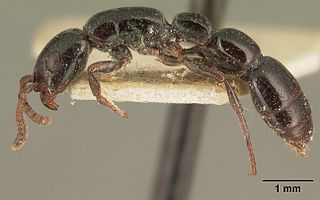| Vicinopone | |
|---|---|
 | |
| V. conciliatrix worker from Ghana | |
| Scientific classification | |
| Kingdom: | |
| Phylum: | |
| Class: | |
| Order: | |
| Family: | |
| Subfamily: | |
| Genus: | Vicinopone Bolton & Fisher, 2012 |
| Species: | V. conciliatrix |
| Binomial name | |
| Vicinopone conciliatrix (Brown, 1975) | |
| Type species | |
| Simopone conciliatrix | |
Vicinopone is a monotypic Afrotropical genus of arboreal ants in the subfamily Dorylinae. [1] [2] Vicinopone conciliatrix, the only species in the genus, was first described as Simopone conciliatrix by Brown in 1975 and was transferred to its own genus by Bolton & Fisher in 2012. V. conciliatrix appears to be quite widely distributed but rare. Its rarity is more likely apparent than real because it nests and forages in trees, rarely if ever coming down to the ground. [3]

In biology, a monotypic taxon is a taxonomic group (taxon) that contains only one immediately subordinate taxon.
A genus is a taxonomic rank used in the biological classification of living and fossil organisms, as well as viruses, in biology. In the hierarchy of biological classification, genus comes above species and below family. In binomial nomenclature, the genus name forms the first part of the binomial species name for each species within the genus.

Ants are eusocial insects of the family Formicidae and, along with the related wasps and bees, belong to the order Hymenoptera. Ants evolved from wasp-like ancestors in the Cretaceous period, about 140 million years ago, and diversified after the rise of flowering plants. More than 12,500 of an estimated total of 22,000 species have been classified. They are easily identified by their elbowed antennae and the distinctive node-like structure that forms their slender waists.














